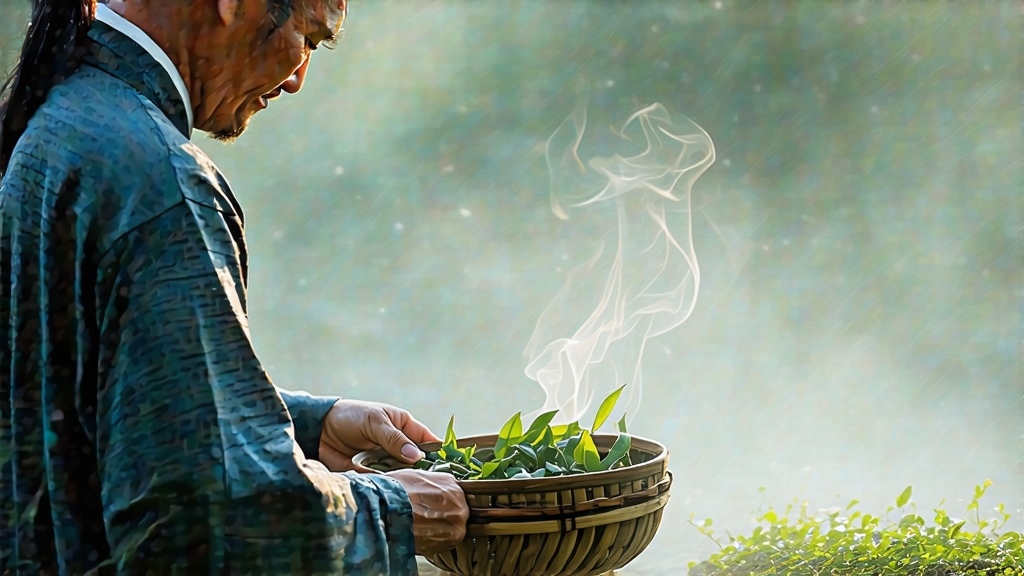
Longjing, literally “Dragon-Well,” is the most celebrated among China’s more than one thousand green-tea varieties. To the Chinese palate it is the archetype of freshness; to foreign drinkers it is often the first green tea whose name they remember. Yet beyond its fame lies a living microcosm of Chinese culture—history tucked into leaf veins, craftsmanship encoded in hand gestures, and landscape distilled into aroma. This essay invites you to travel from the limestone ridges of Hangzhou’s West Lake to the quiet of your own teapot, discovering why a single sip of Longjing can taste like early April in China.
Historical roots
The earliest written record dates to the Tang dynasty (618-907), when the monk-poet Lu Yu listed “Tea from the Lion Peak” in his Classic of Tea. By the Song era (960-1279) the same leaves, now called Longjing, were imperial tribute. The Qianlong Emperor (r. 1735-1796) visited Hugong Temple beside West Lake, plucked bushes himself, and conferred eighteen “imperial” tea trees that still survive on Shifeng Hill. Legends claim a dragon dwells in the well at Longjing village, lending the tea its name and a whisper of rain-soaked mystique. Commerce followed lore: in 1915 Longjing won gold at the Panama-Pacific Exposition; in 2014 it accompanied President Xi to the APEC banquet, sealing its status as China’s diplomatic calling card.
Terroir and sub-varieties
West Lake Longjing is protected by a Chinese geographical indication similar to French AOC. Within the lake’s ring of mist-capped hills, micro-climates create five core sub-zones:
- Shifeng (Lion Peak) – highest elevation, orchid aroma, longest sweet finish.
- Meijiawu – the most abundant, chestnut note, jade-green leaf.
- Wengjiashan – mineral-rich soil, bright bamboo-leaf fragrance.
- Longjing village itself – balanced, classic “bean & orchid” profile.
- Yunqi – slightly cooler, yielding a lighter, more floral cup.
Outside the core zone, Qiantang and Yuezhou counties produce “Zhejiang Longjing,” pleasant yet less concentrated. Purists insist only the 168 square kilometres around West Lake deserve the name, but all share the same cultivars: the traditional Longjing #43 (early budding, uniform leaf), the heirloom Qunti (wild-looking, complex flavour), and the rare Zhongcha 108 (cold-resistant, citrus edge).
From leaf to emerald ribbon: craft in motion
Longjing is pan-fired, not steamed like Japanese sencha, giving it a toasted, nutty character while preserving chlorophyll’s jade colour. The harvest window is brutal: only ten days before Qingming festival (early April) yield the prized Mingqian buds—one tender leaf folded like a sparrow’s tongue around a downy tip. Pickers work from dawn to noon, filling bamboo baskets with the “two leaves and a bud” standard.
Within four hours the leaves must reach the firing room, where masters work on iron woks heated to 80–100 °C. With bare hands they press, tumble, and flick the leaves in a choreography refined since the Ming dynasty. The first firing “kills green,” locking in colour; the second shapes the flat, smooth sword that is Longjing’s trademark. A single kilogram demands 60 000 hand movements and six hours of labour. When done correctly the leaf moisture drops to 6 %, yet enzymes remain alive, allowing subtle ageing that deepens aroma over six months.
Chemical poetry
Pan-firing drives off grassy hexenals and generates pyrazines, the molecules found in roasted nuts. The result is a rare alliance of vegetal and toasted notes. West Lake’s quartz-rich soil adds a flinty minerality, while morning mist slows photosynthesis, boosting L-theanine and creating the signature sweet-umami broth. Laboratory tests of authentic Shifeng lots show 4.2 % amino acids, 22 % polyphenols, and a catechin-to-caffeine ratio that yields calm alertness—what the Chinese call “cha qi,” the gentle breath of tea.
How to brew it like a Hangzhou native
Water: Use spring water at 80 °C. Hard tap water dulls aroma; distilled water flattens body.
Leaf: